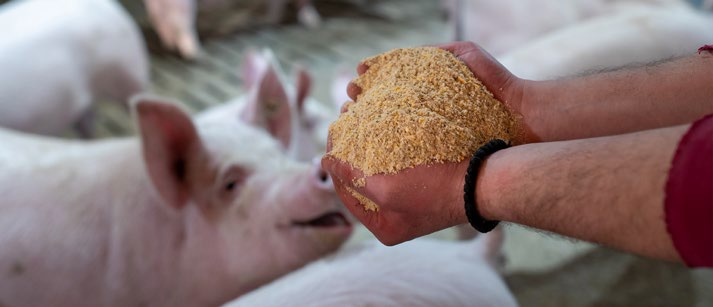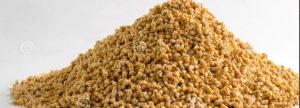 30 May 2023
30 May 2023
Sustainability in Animal Feed Production:Importance of LCA in feed ingredients
Introduction
Reducing the carbon (C) footprint and nitrogen (N) and phosphorus (P) waste in animal production systems is of utmost importance for achieving global food security and sustainability. The agricultural sector, including animal production, is a significant contributor to greenhouse gas emissions and nutrient pollution, which have adverse effects on the environment, climate, and human health. Implementing strategies to minimize these impacts is crucial for ensuring a sustainable and resilient food systems.
Carbon Footprint Reduction
Improved Feed Efficiency
Enhancing feed conversion efficiency is a key approach to reducing the carbon footprint of animal production. By formulating balanced diets, optimizing nutrient utilization, and incorporating innovative feed ingredients, such as by-products or alternative protein sources, the overall carbon emissions per unit of animal product can be reduced.
Manure Management
Efficient management of animal waste, particularly manure, is vital for minimizing greenhouse gas emissions. Implementing anaerobic digestion systems or composting techniques can capture and utilize methane from manure, turning it into a renewable energy source while mitigating its impact on climate change.
Renewable Energy Integration
Utilizing renewable energy sources, such as solar or wind power, to meet the energy needs of animal production facilities can significantly reduce greenhouse gas emissions. Transitioning to clean energy sources helps decouple animal production from fossil fuel dependence and contributes to a more sustainable and low-carbon future.
Nitrogen and Phosphorus Waste Reduction:

As the environmental impact of agriculture receives increased attention, it becomes crucial to evaluate the sustainability of feed ingredients through comprehensive assessments. Life Cycle Assessment (LCA) emerges as a valuable tool for analyzing the environmental footprint of ingredients used in animal feed production.
Understanding Life Cycle Assessment
Life Cycle Assessment is a systematic approach that evaluates the environmental impacts of a product or process throughout its entire life cycle, from raw material extraction to end-of-life disposal. In the context of animal feed production, LCA provides a holistic perspective by assessing the environmental burdens associated with feed ingredient cultivation, processing, transportation, and utilization.
Assessing Feed Ingredient Sustainability:
 The increasing recognition of the environmental impact of swine feed within pork supply chains has led to the adoption of a multi-objective feed formulation approach in the global animal industry. This approach utilizes Life Cycle Assessment (LCA) environmental impact data for feed ingredients to formulate diets that are least-cost, nutritionally adequate, and have low environmental impacts. Several studies have highlighted the potential of this approach in improving the sustainability of animal production systems.
The increasing recognition of the environmental impact of swine feed within pork supply chains has led to the adoption of a multi-objective feed formulation approach in the global animal industry. This approach utilizes Life Cycle Assessment (LCA) environmental impact data for feed ingredients to formulate diets that are least-cost, nutritionally adequate, and have low environmental impacts. Several studies have highlighted the potential of this approach in improving the sustainability of animal production systems.
Study
 Under this context a group of researchers set forth a study where they conducted an LCA of diets fed to growing-finishing pigs within the primary pig production regions in the U.S (Midwest, Mid-Atlantic, Southwest). The assessed diets were corn and soybean meal-based, with or without DDGS inclusion. They also contained other feed additives like: synthetic amino acids, thermally-processed supermarket food waste, and phytase.
Under this context a group of researchers set forth a study where they conducted an LCA of diets fed to growing-finishing pigs within the primary pig production regions in the U.S (Midwest, Mid-Atlantic, Southwest). The assessed diets were corn and soybean meal-based, with or without DDGS inclusion. They also contained other feed additives like: synthetic amino acids, thermally-processed supermarket food waste, and phytase.
Materials and Methods
The feeding programs which were evaluated included:
1) standard corn-soybean meal (CSBM) diets
2) CSBM containing 15% corn distillers dried grains with solubles (DDGS)
3) CSBM with 8.6% thermally processed supermarket food waste (FW)
4) low crude protein CSBM diets supplemented with synthetic amino acids (SAA), and 5) CSBM with
phytase(PHY) added at 600 FTU (phytase units)/kg of diet

Summary of the Results
Final Considerations
Addressing the urgent need to reduce the carbon footprint and mitigate nitrogen and phosphorus waste in animal production systems is critical for global food security and sustainability. By implementing strategies such as improving feed efficiency, optimizing manure management, integrating renewable energy sources, and adopting precision feeding and nutrient management practices, we can reduce the environmental impact of animal production while ensuring efficient resource use. Embracing integrated farming systems and conservation practices further enhances sustainability, biodiversity, and resilience.
Life Cycle Assessment of ingredients used in animal feed production is a vital tool in promoting sustainability and responsible resource management. By quantifying the environmental impacts associated with feed ingredient production, LCA guides the selection of ingredients, optimization of processes, and transparent reporting within the supply chain. Integrating LCA into feed production systems enables the industry to minimize its environmental footprint.
These collective efforts contribute to a more sustainable, climate-smart, and environmentally responsible animal production sector that supports the long-term well-being of our planet and future generations.
You may also like to read: “Precise nutrition is essential for an efficient and sustainable production.”
Source: This abstract was taken and modified from the original cited article: “Gerald C Shurson , Environmental impacts of eco-nutrition swine feeding programs in spatially explicit geographic regions of the United States, Journal of Animal Science, Volume 100, Issue 12, December 2022.”
Subscribe now to the technical magazine of animal nutrition
AUTHORS

Nutritional Interventions to Improve Fertility in Male Broiler Breeders
Edgar O. Oviedo Rondón
The Use of Organic Acids in Poultry: A Natural Path to Health and Productivity
M. Naeem
Synergistic Benefits of Prebiotics and Probiotics in Poultry, Swine, and Cattle
Gustavo Adolfo Quintana-Ospina
Hybrid Rye Potential in Laying Hen Feed Rations
Gwendolyn Jones
A day in the life of phosphorus in pigs: Part I
Rafael Duran Giménez-Rico
Use of enzymes in diets for ruminants
Braulio de la Calle Campos
Minerals and Hoof Health in the Pregnant Sow
Juan Gabriel Espino
Impact of Oxidized Fats on Swine Reproduction and Offspring
Maria Alejandra Perez Alvarado